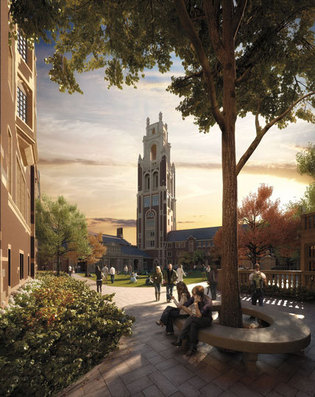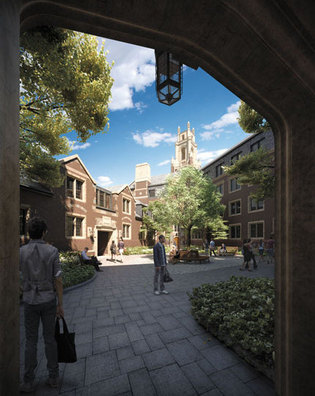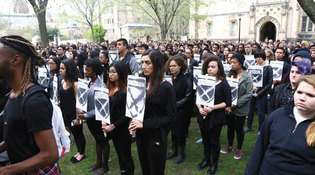 loading
loading
featuresWhat’s in a name?Alumni and students react to decisions about the new residential colleges, Calhoun College, and the title “master.”  Illustration: DBOX for Robert A. M. Stern Architects, LLP.View full image Illustration: DBOX for Robert A. M. Stern Architects, LLP.Illustrations of the colleges, now under construction: the main courtyard of Pauli Murray College (top) and a small court in Benjamin Franklin College (above). View full image Chris RandallAt a demonstration outside Calhoun College after the decision to keep its name was announced (above), students carried signs with alternative names for the college. View full imageSeven years after Yale decided to build two new residential colleges, six years after the university decided not to name the colleges after living donors, and two years after President Peter Salovey ’86PhD called for naming suggestions from the entire Yale community, the campus conversation changed. Last fall, Yale was one of dozens of universities that saw student rallies, protests, and teach-ins about race and free speech—testing the space where the right to express oneself clashes with the right not to be gratuitously insulted. So it was in a climate still alive with debate that, five months later, Yale made its long-planned announcements. The new colleges are named for Benjamin Franklin and Pauli Murray ’65JSD; Calhoun College will keep its name; the title “master” will become “head of college.” The reactions have come in almost every variety. As Salovey told a group of alumni three days after the news was released, the administration had known there would be “significant positive and negative reaction to virtually any decision” they could make. The questions Yale had to resolve—how to address racial issues and how to memorialize history—were profound. They were, said Salovey, “absolutely not ones that lend themselves to popular solutions.” Yale had planned to release its decisions on Thursday evening, April 28. That would have allowed time for the Yale Daily News to cover the story in its final issue on the Friday before Reading Week. In the event, the News learned the decisions on Calhoun and “master” on Wednesday, from an anonymous “high-ranking administrator,” and published them online late in the afternoon. Almost immediately, Yale started e-mailing its own statement on the four decisions to faculty, alumni, students, and staff. As Salovey has noted, the campus and off-campus reactions were quite different. CalhounOn campus, by far the strongest reactions came from the students and faculty who opposed the choice to keep the name of Calhoun College. The renaming question had been circulating on campus for some time. Salovey himself raised it in an address to freshmen last August, soon after the murder of nine people in a black church in Charleston launched a national debate about symbols linked with slavery. At Yale, that debate centered on John C. Calhoun, Class of 1804. Calhoun (1782–1850) had served as vice president under two presidents, US senator, and secretary of defense—and was also one of the most eloquent and effective champions of slavery in US history. To enslave Africans was “a positive good,” Calhoun said, “the most safe and stable basis for free institutions in the world.” In his address, Salovey called for the Yale community to devote “reflective, thorough, and civil consideration” to the question of renaming Calhoun College. Yale had decided to name one of its first nine residential colleges after John C. Calhoun in 1933. There’s little record of how the choice was made or whether it was debated: just a note in the Corporation’s records that a slate of names was approved. Calhoun was the most consequential politician the university had produced at the time, and white America was in a mood of reconciliation about the Civil War, eager to portray the conflict as an honorable dispute about states’ rights—not slavery. But evidence of debate surfaced as early as 1941, when the Yale Daily News ran an article claiming that, because Calhoun had been a secessionist, Yale had decided not to use his name on any college built with the bequest left by John W. Sterling, Class of 1864: it would be “tactless.” (The News gave no source.) By the 1960s, when African American students first started attending Yale in significant numbers, Calhoun’s career as a champion of slavery was harder to ignore. In an essay for their 25th reunion book, Armstead Robinson ’68 and Donald Ogilvie ’68 recalled their “shock, anger, and then outrage” when, as freshmen, they walked into the Calhoun common room and saw the decorations of that period: “Confederate battle flags proudly mounted over the fireplace, and accompanied by two very large bullwhips.” The subject came up occasionally over the succeeding decades. When Chris Rabb ’92 was assigned to Calhoun, he complained to the master about a stained-glass window in the common room that showed Calhoun with a shackled slave at his feet. (The slave was removed from the image; Calhoun remained.) In 2014, when Calhoun College held an all-classes reunion, a panel discussion considered the name. Yale College dean Jonathan Holloway ’95PhD, an African American historian who was then master of Calhoun, argued that the name should remain “as an open sore, frankly, for the very purpose of having conversations about this.” Explaining the university’s decision this April to keep the name, Salovey told a group of alumni it had been based on the principle that “we’re an educational institution and we can best educate not by hiding aspects of our past, but by examining them.” While Salovey has said that he finds Calhoun’s views on slavery “despicable,” he added that “the whole story is part of our legacy as a university and it’s part of our legacy as a country.” In his letter to the campus and alumni, he wrote: “Removing Calhoun’s name obscures the legacy of slavery rather than addressing it.” Salovey added that the university would begin an “interactive history project” focusing on Calhoun and “the lesser-known people, events, and narratives behind the familiar facades we see as we walk through the campus.” He also announced that there will be a juried competition to create an original work of art for Calhoun College that will “respond to the realities and consequences of Calhoun’s life.” Reaction to the announcement was unsurprisingly divided. In an open letter to Salovey, who is Jewish, American studies professor Matthew Jacobson asked him to imagine “how it might feel to go to school and be assigned to a residential college named for Joseph Goebbels.” In a New York Times op-ed, history professor Glenda Gilmore wrote: “The decision to retain the Calhoun name continues the pain inflicted every day on students who live in a dormitory named for a man distinguished by being one of the country’s most egregious racists.” After an intense meeting of the Yale College faculty, an open letter was circulated urging that the decision be reversed and the name changed. By May 11, 283 faculty had signed. A vocal group of students also expressed their criticism. On April 29, protestors—some 600, mostly students, according to the Yale Daily News—gathered on Cross Campus for a symbolic renaming of the college. They carried signs with dozens of potential namesakes, including slave rebellion leader Nat Turner and Edward Bouchet (whose 1874 Yale doctorate made him the first African American to earn a US PhD). They also declared that they would refer to Calhoun as “the college formerly known as Calhoun” for the time being. On the other hand, two thirds of the 350-plus alumni who responded to questions the Yale Alumni Magazine e-mailed to our Reader Panel approved of the Calhoun decision. (The Reader Panel is an opt-in group and can’t be considered statistically representative of Yale alumni.) “I think the president did right in not whitewashing history,” wrote William Weston ’88PhD. “I think the college has an obligation to teach the controversy.” Steven Cousins ’77 wrote, “As an African American member of the Yale Class of 1977 . . . I am proud that Yale, true to its enduring principles, undertook a thoughtful, balanced, progressive, and measured approach to these momentous issues of historic significance. This was, no doubt, done in full recognition that there would be no perfect solution to a set of issues as inherently divisive as slavery, race, and their legacies—issues, in microcosm, with which the country continues to struggle, from Ferguson (my hometown) to Florida.” The thoughts of Harvard history professor Henry Louis Gates Jr. ’73, an African American Calhoun alumnus, reflect the complexity of the question. Gates had argued, in a March 7 letter to Salovey that he released to the alumni magazine, for keeping the name. “Charles Davis, Calhoun’s first black master, loved every second of the fact that his presence, and that of students such as me, implicitly refuted John C.’s idiotic notions about black mental capacity every second of every single day,” wrote Gates. “I would not encourage you and the Corporation to change the name.” Since the decision, Gates has told the alumni magazine and Salovey that he now believes Yale “should endow a chair in the history of slavery, and name it after John W. Blassingame Sr., the first black person to receive tenure in the history department, and the author of The Slave Community, the first study of slavery that used the narratives written by former slaves themselves as historical evidence for the nature of ‘the peculiar institution.’” Gates says that he is philosophically opposed to name changes in general, but now suggests a possible compromise solution for Calhoun College: “Adding the name of Yale’s first black PhD, Edward Bouchet, to the college (hence Bouchet-Calhoun College) could be a rather creative innovation, at once preserving the identity of the college for its alumni, while addressing the justified concerns of those of us who find John C. Calhoun’s views on race so very deeply disturbing.”
|
|